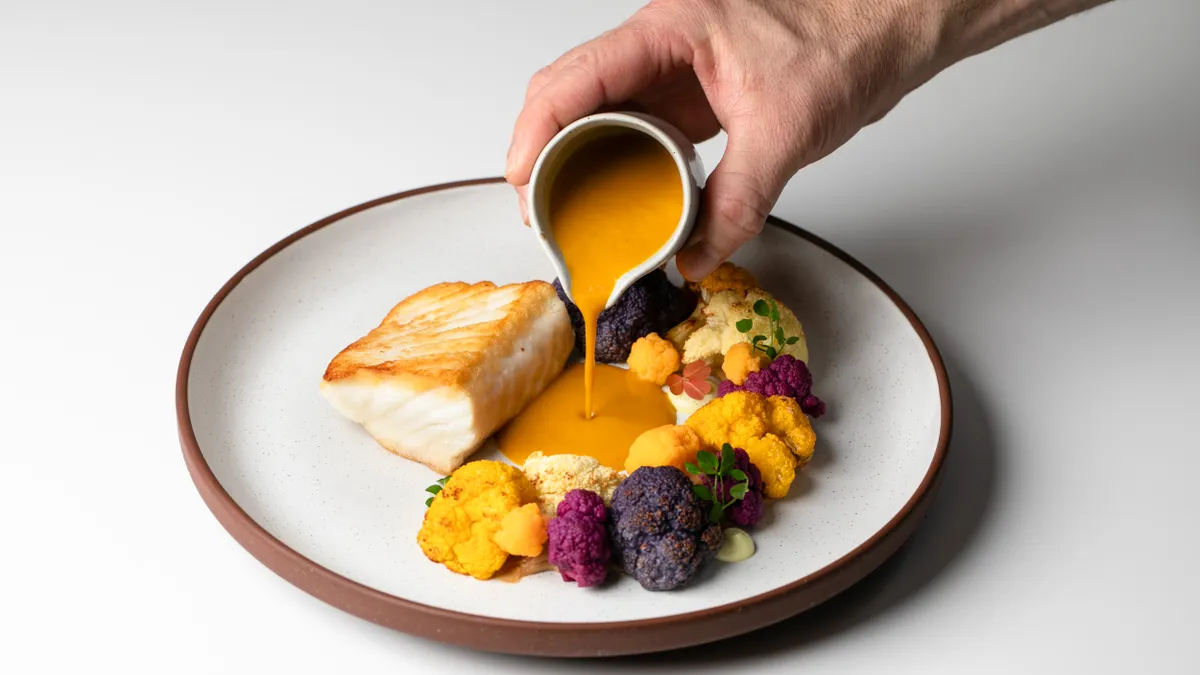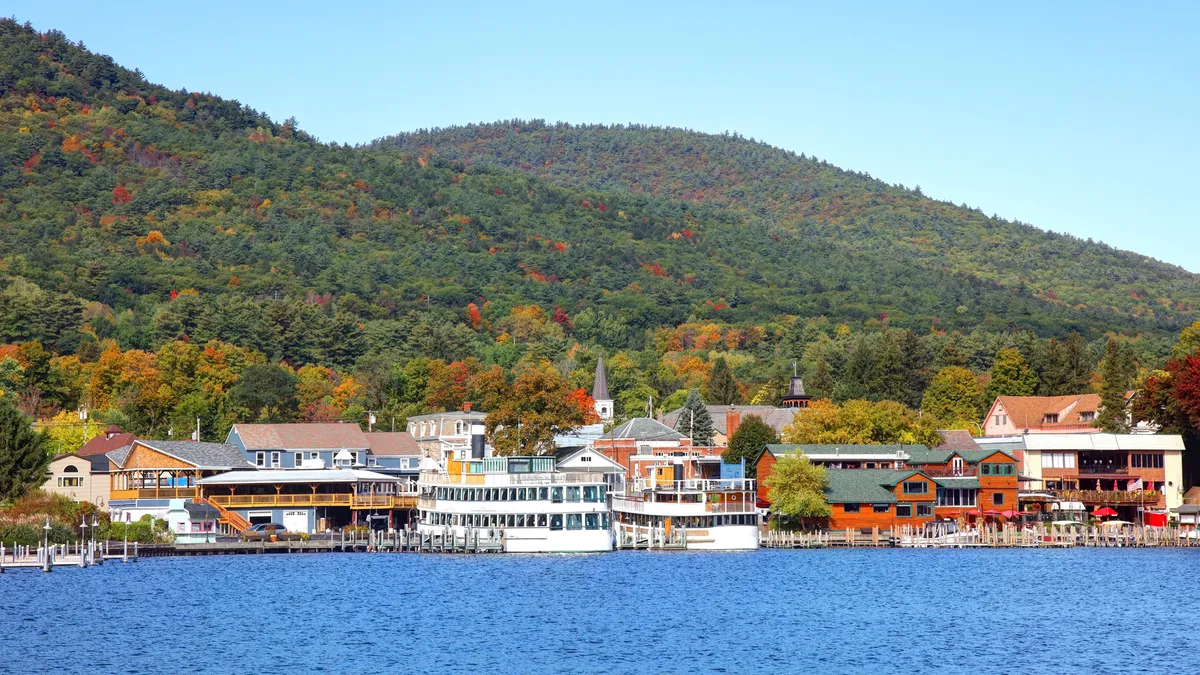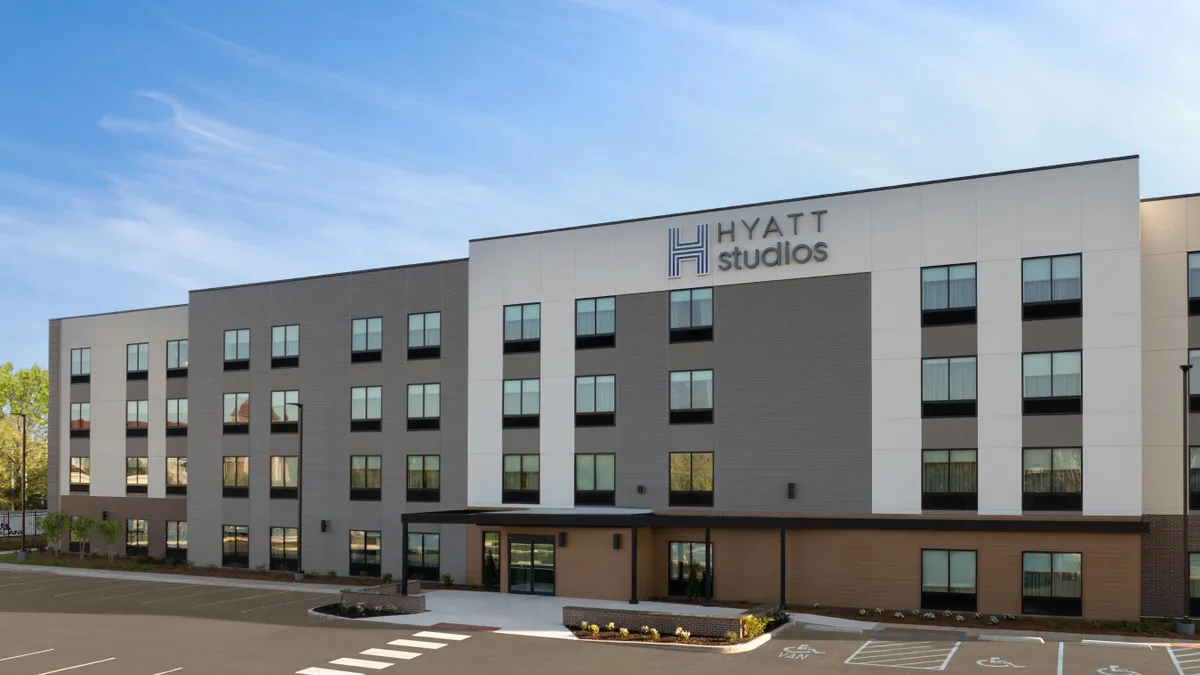Agave-forward cocktails and elevated takes on Mexican regional fare are the stars of the show at Ceiba, the signature food and beverage spot at Hilton’s new Conrad Orlando hotel. But Ceiba’s elegant rooftop setting offers the promise of predictable entertainment, too, thanks to what Hilton Senior Vice President and Global Head of Food and Beverage Brands Adam Crocini calls “unparalleled views” of nearby Walt Disney World’s famed fireworks displays.
Ceiba, which overlooks the property’s 8-acre, sand-rimmed lagoon, is one of five “bespoke concepts” created for Conrad by StiR Creative Collective by Hilton, Crocini said. Another, the Polynesian-inspired Papaya Club near the lagoon’s shore, tapped mixologist Paul McGee — known for his tropical-inspired cocktails — to develop a drinks menu worthy of a South Pacific beach resort. Guests sip McGee’s creations at tables overlooking the lagoon or farther-flung cabanas and loungers, extending the experience throughout the property.
Conrad Orlando’s food and beverage concepts reflect a wider trend within the hospitality industry toward memorable restaurant and lounge experiences rooted in a sense of place, even when they honor flavors first developed thousands of miles away.
“For Hilton, a successful hotel restaurant will have a strong narrative interwoven throughout every aspect of the space, experience and service program,” Crocini said. “The narrative, if thoughtfully curated and executed, will leave the guest with an impression of their dining experience.”
These narratives are as varied as the properties themselves, drawing a throughline from menu design and sourcing to restaurant decor. And increasingly, they cater not only to hotel guests, but also to locals seeking out-of-the-ordinary culinary experiences in their own backyards.
‘The plot of your story’
A “thoughtfully curated and executed” narrative comes through “in all the touchpoints, from brand design and collateral to staff uniforms and servingware,” Crocini said. But the food and beverage menus themselves are its linchpins — “the plot of your story.”
Other hotel restaurants are prioritizing a strong narrative, too.
Remington Hospitality’s Lucy Restaurant & Bar — the dining centerpiece of the Bardessono Hotel and Spa in Yountville, California — emphasizes its Napa Valley setting and the avid gardening habits of late namesake Lucy Bardessono. Lucy features a certified organic garden that supplies cocktail herbs and produce for its veggie-heavy food menu, according to Remington Hospitality Senior Vice President of Food and Beverage Operations Ted Peters.
Locally and regionally inspired ingredients also tell the story — albeit in a very different way — at Remington’s Urban Spur and Bar at the Dallas/Fort Worth Airport Marriott.
Serving a clientele heavy on business travelers, Urban Spur showcases “American fare [with] Texas soul… which fits the location, the region and the needs of the guest,” Peters said. The menu features rustic cuisine with an emphasis on barbecue flavors and plenty of the meat-forward entrees that outsiders might crave on a visit to the Lone Star State.
We are hearing from guests and operators there is a shift in guest expectations, a desire to receive the quality of food and beverage one might associate with a traditional fine dining venue but in a more contemporary and relaxed environment.

Adam Crocini
senior vice president and global head of food and beverage brands, Hilton
But Urban Spur’s menu also boasts lighter, plant- and fish-based fare that diners could expect to find at just about any upscale American-style restaurant today. According to Peters, that's reflective of a broader shift — an overarching narrative knitting together the “plots” of many individual restaurant menus — toward health- and planet-conscious hotel dining.
“COVID really set the pace for more health-conscious diners,” Peters said.
Now, Peters estimates that between 25% and 30% of Remington’s menus are “more health-focused,” with an emphasis on fresh, organic, plant-based ingredients. Diners’ growing preference for regionally sourced ingredients that produce less waste and carbon emissions is related to their surging interest in wellness, Peters said.
The shift “has been a plus for us because our teams are learning about sustainability,” an increasingly important consideration for travelers choosing where to stay and dine, Peters added.
Memorable menus, memorable experiences
Countless books and movies have cohesive, engrossing narratives that captivate audiences from start to finish. But truly memorable cultural products go farther — think the then-groundbreaking computer-generated alien landscapes and characters of the first Avatar film, or the jaw-dropping twist at the end of The Sixth Sense.
So it is in the hospitality world.
Along with music and lighting choices that “can make or break a dining experience,” standout hotel food and beverage concepts today feature “interactions and moments designed to leave an impression,” Crocini said.
The “true showstopper” at Capolinea, the Italian fine-dining restaurant at the new, 976-room Signia By Hilton Atlanta Georgia World Congress Center, is a tableside martini service “featuring a sleek trolley with a selection of the coldest martinis in Atlanta,” said Jacob Linzey, the property’s director of food and beverage.
“Coldest martinis in Atlanta” is an understatement. Capolinea uses liquid nitrogen to “chill and garnish the glass to minus 350 degrees,” Linzey said.
Capolinea’s signature experience plays right into its food and beverage narrative. Lucy’s signature experience does as well: the restaurant encourages guests to walk through the organic garden to see and smell — if not touch — fruits, herbs and veggies that could end up in their dinner.
Other experiences are less culinary than historical.
That’s the case for Julia, a Remington restaurant and bar at La Posada de Santa Fe. Julia’s elegant, understated Old Southwest decor and cuisine ready diners to feel the presence of the 19th-century matriarch whose spirit is said to inhabit the property.
The effect “is all-encompassing,” Peters said. “People say they’ve seen [Julia’s ghost] in the stairwell.
These narrative-driven experiences are becoming more prevalent as many hotel restaurants dial back more formal trappings, Crocini said.
The story of the food, the story of the property — this is what keeps people coming back.

Ted Peters
senior vice president of food and beverage operations, Remington Hospitality
“We are hearing from guests and operators there is a shift in guest expectations, a desire to receive the quality of food and beverage one might associate with a traditional fine dining venue but in a more contemporary and relaxed environment,” he said.
Case in point is San Laurel at Conrad Los Angeles, a high-end concept Crocini’s team developed in partnership with José Andrés Group. San Laurel’s Spanish-inflected menu boasts rarefied proteins like bone-in Wagyu ribeye, sea urchin and caviar, and parts of the dining room offer stunning 10th-floor views of Los Angeles’ iconic Walt Disney Concert Hall, but “the service takes its cues from the Southern California location and audience — attentive but with a lighter, more relaxed touch,” Crocini said.
San Laurel nods to guests’ evolving relationship with high-end travel and dining experiences. One in five travelers have a negative view of the term “luxury,” preferring language like “unique,” “personalized” and “authentic,” Morning Consult found last year. They’re more focused on customer service as well, with 55% of respondents saying great service is an essential ingredient of “luxury” travel.
Concepts that stand on their own
Menus, decor and service that create a sense of place, memorable experiences guests can’t find anywhere else — in larger urban centers, these features help attract local residents and office-dwellers to fill seats alongside farther-flung guests, hotel food and beverage experts say.
“The story of the food, the story of the property — this is what keeps people coming back,” Peters said.
But some Remington concepts go farther and offer special events like cooking classes and theme nights to “build the infrastructure of the local community,” he said. Others emphasize chef-driven menus or extensive wine and beverage programs, just as higher-end urban restaurants not attached to hotel or resort properties might.
Remington has also looked to behind-the-scenes improvements to enhance the customer experience and attract local repeat guests, Peters said.
One example: swapping out clunky hotel point-of-sale systems for more user-friendly restaurant POS software like Toast. Another: moving to familiar digital reservation systems like OpenTable, which remain relatively uncommon in hotel restaurants but which local guests are more comfortable with, Peters said.
“We are driving [the adoption of] restaurant technology in hotels,” he said.
Convenience is important for attracting locals as well, Signia by Hilton Atlanta’s Linzey said. The eight-concept property’s open-to-the-public Lobby Bar complements Highball, a guests-only rooftop pool bar.
Thanks in part to Signia by Hilton Atlanta’s location near the city’s commercial core, “The Lobby Bar aims to serve as Atlanta’s downtown hub for residents and travelers,” Linzey said.
And the property’s very different Nest on Four is designed to appeal to fans pregaming Atlanta Falcons matchups at nearby Mercedes-Benz Stadium. The modern sports bar offers elevated “stadium favorites” like burgers, wings and nachos — and the opportunity to watch the action on the concept’s “halo board of TVs.”
“Nest on Four offers the perfect opportunity for locals or guests to enjoy time together before heading out to the big game,” Linzey said.

















